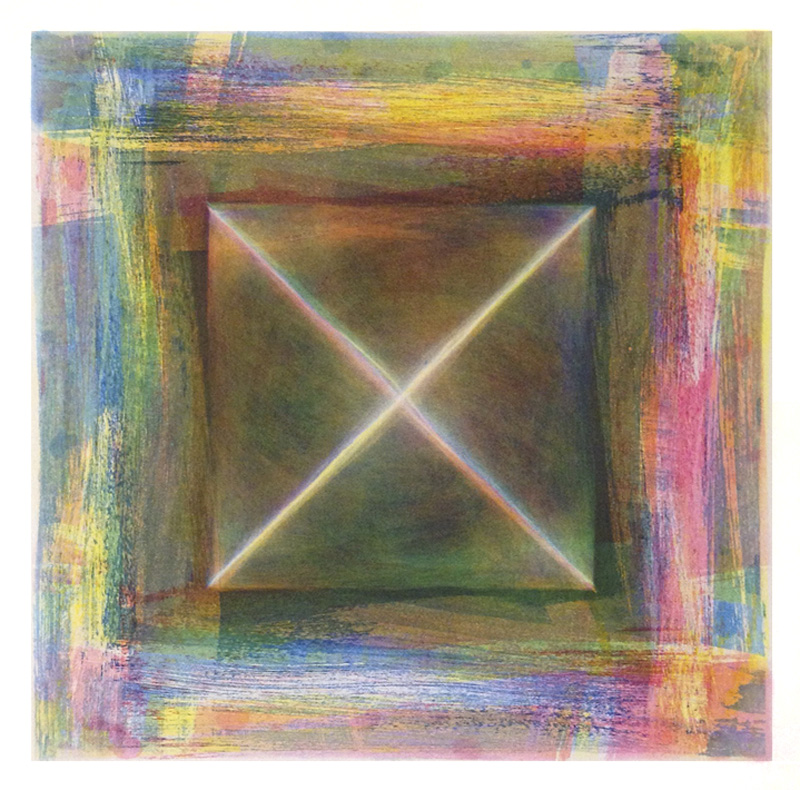I was living in Paris in an apartment on rue Daguerre and working at Atelier Lacourière et Frélaut; Jacques and Robert Frélaut showed me their approach to making aquatints. Luc Guerin pulled the proofs and printed the edition. The title was inspired by my daily commute on the metro, across the city, from Montparnasse to Montmartre. Like the title, the image was born out of the crush of the commute, the press of bodies, the heat of friction, cacophony of metal on metal, unexpected flashes of light, lurching, swaying, through darkened tunnels, unique aromas associated with the different stations, then up and down the stairs, out into the light, and never seeing the same travelers coming and going each day.
The next year I moved closer to the atelier, where we had the opportunity to sublet a live/work space at le Bateau Lavoir. Primary X ², in a sense is a companion piece to Metro. It too is an aquatint etching, using the spit-bite method, printed in the primary colors. I wanted to work directly with Robert Frélaut because of his wide ranging experience with color printing and spit-bite aquatint in particular. An American friend of mine was developing some new color inks and I thought it would be interesting to take some along to see how the printers would like, or dislike, them. During the proofing stages I worked with Luc Guerin again, as I would proof in black and white. As the plate evolved and we began printing the colors I asked if they would like to try the American inks. The first day of color proofing was with yellow; the inks were spread out, mixed with the ink knife for consistency, and there was a general, oui, ça va, it’s okay. So the yellow was printed and left overnight in preparation for the second color, red. The next day red was printed over the yellow with good results, and a couple of the printers came over to inspect, showing interest, but, soon were back at their workstations continuing with their work of the day. On day three I brought out the blue. The plate was inked and I was excited to see how things were going to line up and mix. The ancient press and gears would creak and grind as the press bed began its journey between the massive steel rollers, with the felts pressing the paper down into the copper plate. After the bed came to a rest on the other side of the rollers, the felts were thrown back over the top roller and the paper was pulled from the plate and laid on the table for inspection. I was pleased to see the results, as the gestures of the brushwork aligned and colors mixed as I had planned. At this moment everyone gathered to look and admire the proof. Positive remarks all around, the inks were acceptable, perhaps a little more buttery than the French inks. Then Carlos, whose press and ink station were at the end of the atelier chimed in, Les couleurs comme les voitures americaines- colors like your american cars. I left the plate for steel facing and made arrangements with Nanie for all of the details. Robert Frélaut printed the edition, and I suspect, he used the French inks.



Hello Thomas
I am an Australian printmaker who lived in Paris from 1975-1979. I attended the École Nationale Superièure des Arts Decoratifs for two years. Jacques Frélaut was our ‘technician’. He came to the school once per week to help us with our printing. A wonderful generous man who lived and breathed printmaking. I still have the scraper he bound with string for me. Thank you for writing about your experiences there.
Nice to hear from you. Jacques was truly a warm human being. An honor to know him and a joy to work in his presence.
Hallo Thomas,
When were you working at Lacourière et Frélaut? And are you in touch with anyone now? My time there in the 1970s was one of the happiest of my life. But when I sent a friend over some months ago to give them my best wishes, he found that the studio had been replaced by a restaurant…. I’d be very grateful for contact details for any of them.
Best wishes, Sylvia
I also worked at Atelier Lacourière-Frélaut in the 70s & 80s. Would love to correspond and reminisce with anyone remembering those good, irreplaceable times.